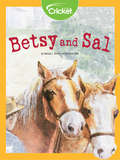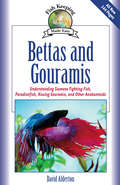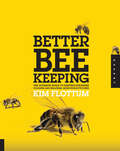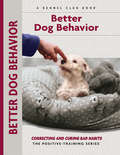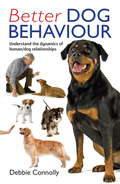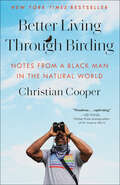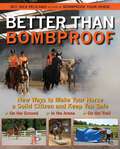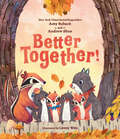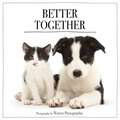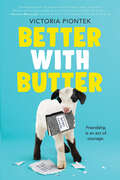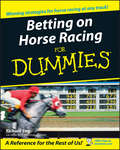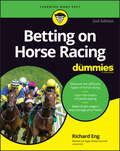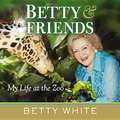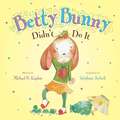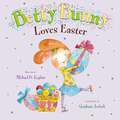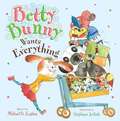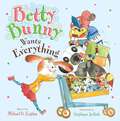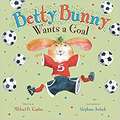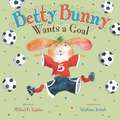- Table View
- List View
Betsy and Sal
by Wanda L. SmithIt’s 1937 and Pa wants to buy a new tractor to plow his farm. He can only afford the tractor if he sells his two Belgian mares, Betsy and Sal. Emmy and her sisters disagree. Will Betsy and Sal prove their worth? Or will Pa sell them to buy his tractor?
Bettas and Gouramis
by David AldertonDavid Alderton's investigation of anabantoids, the Asiatic gouramis-the bettas and gouramis, including Siamese fighting fish, paradisefish, kissing gouramis, begins with a look at the origins of these adaptable and widely varying fishes in their Asiatic homelands, where they've been popular for hundreds of years. Given the considerable size range of this group of fishes, from the tiny licorice gourami (only 1.5 in or 4 cm in length) to the giant gourami (about 28 in or 70 cm), there are great differences to be considered by the fish keeper, all of which are addressed by Alderton in this color guide. The anabantoids is also a large group of fishes, with one hundred varieties/species available in most pet and hobby stores. The book provides photographs and images of dozens of the most popular examples.Chapter two is devoted to "The Different Groups," and the author explains how the classifications of anabantoids work and then proceeds to discuss the members of each family. In all, eighteen genuses are described in detail, including their natural ranges, physical characteristics, abilities, behaviors, and breeding facts. The author discusses the specific traits of the anabantoids, including their unique labyrinth organs, swim bladders, hearing ability, lateral line, and locomotion.The section on care discusses the selection and positioning of the aquarium, planting, flooring, water, filtration, heating, and lighting. The guide gives specific advice on feeding habits and food, including foraging and hunting techniques of certain anabantoids and the various kinds of food (prepared diets, green food, live food) that are best for individual species. For readers interested in breeding bettas and gouramis, the chapter on reproduction will prove exceptionally helpful, giving expert guidance on preparing for and encouraging spawning behavior, nest building, and rearing the fry. The author also provides information on color genetics for breeding Betta splendens.The general health of the Asian gouramis is covered in a chapter called "Lifespan and Diseases," including a primer on preventing and managing parasitic illness, bacterial and fungal diseases, dietary problems, and more. In the book's final chapter "Popular Anabantoids," the author presents a full-page of text and photographs for twenty-six different species of the families Belontiidae, Anabantidae, Osphronemidae, Helostomatidae, and Luciocephalidae. Resources and glossary conclude the volume.
Better Beekeeping: The Ultimate Guide to Keeping Stronger Colonies and Healthier, More Productive Bees
by Kim Flottum“The most lucid call to action ever written about land-based beekeeping” from the author of The Backyard Beekeeper (Tammy Horn, author of Bees in America and Beeconomy).Backyard beekeepers everywhere agree: a successful colony is a thing of beauty.Thousands of beekeepers have started beekeeping thanks to Kim Flottum’s first book, The Backyard Beekeeper, and they have added to their repertoire of skills with The Backyard Beekeeper’s Honey Handbook. Now, Better Beekeeping answers the question, “What do I do now that I’m a beekeeper?” This book takes serious beekeepers past the beginning stages and learning curves and offers solutions and rewards for keeping bees a better way. Better queens, better winters, better food, and better bees await any beekeeper willing to take on the challenge of having the right number of bees, of the right age, in the right place, in the right condition, at the right time.“There are numerous beekeeping books on the shelves that instruct on ‘how to,’ but Better Beekeeping is a book that explores ‘why to,’ which is essential for this ever-changing world of beekeeping today.” —Jennifer Berry, research coordinator at the University of Georgia’s Honey Bee Research Lab, commercial queen, and columnist for Bee Culture magazine
Better Dog Behavior and Training
by Charlotte SchwartzFrom puppy to senior - and every stage of life in between - Positive-Training Series books offer fanciers savvy advice straight from the experts.
Better Dog Behaviour
by Debbie ConnollyMany dog owners in the UK don't understand the dynamics of human/dog relationships and consequently experience problems with their pets, such as barking, aggression, chasing livestock, chewing, pulling and running away. Experienced dog trainer Debbie Connolly shows new and experienced dog owners alike how to deal with such behaviour problems, so that the dog can become a safe and happy member of their family.Debbie recounts real-life anecdotes to get across the serious point that you are playing with your dog's life, if you can't or won't learn to treat your dog appropriately.Some of the stories she tells are funny, some are sad, but all of them are easy for her readers to identify with and relate to.She explains how to get a dog from the right source and how to live with it afterwards.She gives practical advice on how to solve all the common problems dog owners face. And she isn't afraid to raise important issues that others avoid - issues that dog owners actually face in the real world, for example, when you should give up and put your dog to sleep.
Better Dog Behaviour
by Debbie ConnollyMany dog owners in the UK don't understand the dynamics of human/dog relationships and consequently experience problems with their pets, such as barking, aggression, chasing livestock, chewing, pulling and running away. Experienced dog trainer Debbie Connolly shows new and experienced dog owners alike how to deal with such behaviour problems, so that the dog can become a safe and happy member of their family.Debbie recounts real-life anecdotes to get across the serious point that you are playing with your dog's life, if you can't or won't learn to treat your dog appropriately.Some of the stories she tells are funny, some are sad, but all of them are easy for her readers to identify with and relate to.She explains how to get a dog from the right source and how to live with it afterwards.She gives practical advice on how to solve all the common problems dog owners face. And she isn't afraid to raise important issues that others avoid - issues that dog owners actually face in the real world, for example, when you should give up and put your dog to sleep.
Better Living Through Birding: Notes from a Black Man in the Natural World
by Christian CooperNEW YORK TIMES BESTSELLER • Central Park birder Christian Cooper takes us beyond the viral video that shocked a nation and into a world of avian adventures, global excursions, and the unexpected lessons you can learn from a life spent looking up.&“Wondrous . . . captivating.&”—Ed Yong, Pulitzer Prize–winning author of An Immense WorldChristian Cooper is a self-described &“Blerd&” (Black nerd), an avid comics fan and expert birder who devotes every spring to gazing upon the migratory birds that stop to rest in Central Park, just a subway ride away from where he lives in New York City. While in the park one morning in May 2020, Cooper was engaged in the birdwatching ritual that had been a part of his life since he was ten years old when what might have been a routine encounter with a dog walker exploded age-old racial tensions. Cooper&’s viral video of the incident would send shock waves through the nation.In Better Living Through Birding, Cooper tells the story of his extraordinary life leading up to the now-infamous incident in Central Park and shows how a life spent looking up at the birds prepared him, in the most uncanny of ways, to be a gay, Black man in America today. From sharpened senses that work just as well at a protest as in a park to what a bird like the Common Grackle can teach us about self-acceptance, Better Living Through Birding exults in the pleasures of a life lived in pursuit of the natural world and invites you to discover them yourself.Equal parts memoir, travelogue, and primer on the art of birding, this is Cooper&’s story of learning to claim and defend space for himself and others like him, from his days at Marvel Comics introducing the first gay storylines to vivid and life-changing birding expeditions through Africa, Australia, the Americas, and the Himalayas. Better Living Through Birding recounts Cooper&’s journey through the wonderful world of birds and what they can teach us about life, if only we would look and listen.
Better Off Read (A Bookmobile Mystery #1)
by Nora PageWhen her best hope of saving her storm-damaged library is found murdered, senior librarian Cleo Watkins hits the road in her bookmobile in search of justice.Septuagenarian librarian Cleo Watkins won’t be shushed when an upstart young mayor threatens to permanently shelve her tiny town’s storm-damaged library. She takes to her bookmobile, Words on Wheels, to collect allies and rally library support throughout Catalpa Springs, Georgia.However, Cleo soon rolls into trouble. A major benefactor known for his eccentric DIY projects requests all available books on getting away with murder. He’s no Georgia peach, and Cleo wonders if she should worry about his plans. She knows she should when she discovers him bludgeoned and evidence points to her best friend, Mary-Rose Garland. Sure of Mary-Rose’s innocence, Cleo applies her librarian’s sleuthing skills to the case, assisted by friends, family, and the dapper antiquarian bookseller everyone keeps calling her boyfriend. Evidence stacks up, but a killer is overdue to strike again. With lives and her library on the line, Cleo must shift into high gear to close the book on murder in Better Off Read, the charming Bookmobile series debut by Nora Page.
Better Than Bombproof
by Rick PelicanoIn his bestselling first bookBombproof Your Horse, Sergeant Rick Pelicano of the Maryland National Park Police shared the one-of-a-kind, step-by-step exercises he uses to prepare police horses and riders for duty. By doing so, he transformed the concept of bombproof into a proactive form of training thatanyrider can apply to her horse. Now he's back and taking bombproof to a whole new level.Sergeant Pelicano exposes the most common problems he sees in his bombproofing clinic's lack of rider control, rider fear or anxiety, and herd-bound horses, to name a few. He provides the techniques that have successfully countered these situations—groundwork such as longeing and long-lining around and past scary obstacles, for example.He also arms you with the seven magic under-saddle skills he feels every horse should know some movements from the dressage ring and others from the world of Western riding. These are the tools you need when faced with the possibility of your horse rearing, shying, running for the hills, or otherwise reacting in a dangerous or uncontrolled manner.Sergeant Pelicano also tackles complex compound bombproofing situations, such as opening and closing gates, carrying flags, and discharging firearms from the saddle. And, a bombproof horse is the perfect mount to ride in parades, drill teams, and musical demonstrations—participating in these activities actually furthers his bombproof training by continuously exposing him to different sights, sounds, and settings.Better than Bombproofis chock full of information on how to prepare an equestrian group for a parade, ride in formation, and perform with a drill team—including 11 specialized movements, a complete sample ride, and details on how to time your ride to music.With additional chapters on easy-to-use trailer-loading techniques as well as some of the unique games on horseback that Sergeant Pelicano plays with his police unit to enforce horse and rider skills, you're sure to find an exciting new array of exercises to help further desensitize your horse to potentially frightening situations. Plus, a special section on defensive riding techniques shows you how to avoid a suspicious individual or counter an attacker when out on the trail—just one more way to help you feel safer and more confident every time you get in the saddle.
Better Together!
by Amy Robach Andrew ShueFrom Good Morning America anchor Amy Robach and her husband, actor Andrew Shue comes a sweet tale about finding common ground and accepting and appreciating each others' differences.When a big thunderstorm shakes their woodland home, the Squirrelly family must flee their nest for a hollow in an oak tree. To their surprise, the McMunk family had the exact same idea. This family of squirrels and a family of chipmunks must find ways to live together--which isn't always easy since they come from different backgrounds. But after some important lessons in compromise, the Squirrellys and the McMunks realize that life is better together as the McSquirrelies.
Better Together: Life Is Best with a Friend Like You
by Zondervan Warren PhotographicWouldn't life be boring if we were all exactly the same? And although each of us is unique, we're really not so different after all. And it's our differences that truly make us Better Together.Better Together combines adorable photos of unlikely animal pairs alongside poignant quotes on topics for friends of all stripes on subjects such as love, respect, and compassion. Memorable, wise words alongside sweet photography beautifully and humorously communicate the truth about and magic of friendship—that although we may not be exactly the same, we're really not so different after all.Quotes from George Washington to Bono focus on friendship, unity, strength, and on harmony between people with diverse viewpoints, lifestyles, or beliefs and include inspiring quotes such as: "Do I not destroy my enemies when I make them my friends?" -Abraham Lincoln"Friendship is born at that moment when one person says to another: 'What! You too? I thought I was the only one.'" -C. S. Lewis"'Stay' is a charming word in a friend's vocabulary." -Louisa May Alcott "I would rather walk with a friend in the dark than walk alone in the light." -Helen KellerBetter Together is full of reminders of the very best things about friendship and is the perfect way to tell someone you love: "Life is best with a friend like you."
Better With Butter
by Victoria PiontekA girl with anxiety disorder finds an unlikely friend -- and emotional support animal -- in the form of an adorable fainting goat.Twelve-year-old Marvel is afraid of absolutely everything -- amusement park rides, food poisoning, earthquakes, and that big island of plastic floating through the ocean. She also obsesses about smaller worries like making friends, getting called on by the teacher, and walking home alone.Her parents and the school therapist call her worries an anxiety disorder, but Marvel calls them armor. If something can happen, it will. She needs to be prepared.But when Marvel stumbles on a group of older kids teasing a baby goat that has mysteriously shown up on the soccer field, she momentarily forgets to be afraid and rescues the frightened animal.Only Butter isn't any old goat. She's a fainting goat. When Butter feels panic, she freezes up and falls over. Marvel knows exactly how Butter feels and precisely what Butter needs -- her.Twelve-year-old Marvel is afraid of absolutely everything -- amusement park rides, food poisoning, earthquakes, and that big island of plastic floating through the ocean. She also obsesses about smaller worries like making friends, getting called on by the teacher, and walking home alone.Her parents and the school therapist call her worries an anxiety disorder, but Marvel calls them armor. If something can happen, it will. She needs to be prepared.But when Marvel stumbles on a group of older kids teasing a baby goat that has mysteriously shown up on the soccer field, she momentarily forgets to be afraid and rescues the frightened animal.Only Butter isn't any old goat. She's a fainting goat. When Butter feels panic, she freezes up and falls over. Marvel knows exactly how Butter feels and precisely what Butter needs--her.Soon, the two are inseparable, and Butter thrives under Marvel's support. But Butter also helps Marvel. Everything is better with Butter by her side, and Marvel starts to imagine a life in which she doesn’t have to be so afraid . . . until she’s told she might have to give up Butter forever. Will Marvel find a way to fight for her friend? Or will she revert back to the anxious, lonely person she used to be?
Betting on Horse Racing For Dummies
by Richard EngHow to enjoy a day at the races-and bet to win! The last two years have seen a record number of Americans tune in for climatic Triple Crown races featuring Smarty Jones and Funny Cide; in 2004, television viewership jumped a whopping 61 percent over the record set in 2003, and the Belmont Stakes race itself drew a record crowd of more than 120,000! This easy-to-understand guide shows first-time visitors to the track how to enjoy the sport of horse racing-and make smart bets. It explains what goes on at the track, what to look for in horses and jockeys, how to read a racing form and do simple handicapping, and how to manage betting funds and make wagers that stand a good chance of paying off. Complete with coverage of off-track and online betting, it's just what anyone needs to play the ponies-and win! Richard Eng (Las Vegas, NV) is a racing writer and handicapper for the Las Vegas Review-Journal, a columnist for the Daily Racing Form, and the host of a horseracing radio program in Las Vegas. He was formerly a part of the ABC Sports team that covered the Triple Crown.
Betting on Horse Racing For Dummies
by Richard EngBetting on Horse Racing For Dummies is packed with information that teaches you the ins and outs of the racetrack. You&’ll learn how to improve your odds, avoid common betting mistakes, and just plain have fun at the races. This is a spectator&’s easy-to-understand guide, so you&’ll have no trouble identifying the racing breeds with their strengths and weaknesses, sizing up the jockey, understanding the importance and role of a trainer, placing bets, managing money, and beyond. Can&’t make it to the track? No worries! You&’ll get the scoop on online betting with off track betting sites and apps. This update covers the latest changes in the betting world and in the racing world, so you&’ll know just what you&’re wagering. Learn about the different types of horse racing Discover and identify the best racing breeds Know your jockeys and trainers Make smart wagers and manage your fundsFor beginning betters, Betting on Horse Racing For Dummies is your ticket to well informed wagers and a winning edge. Already know the ropes? You&’ll love the market trends and insider tips you&’ll find inside.
Betting on the Maverick: Betting On The Maverick The Boss's Marriage Plan The Puppy Proposal (Montana Mavericks: What Happened at the Wedding? #4)
by Cindy KirkHOW LUCKY CAN YOU GET? Rust Creek Ramblings You heard it here first: Good ol' boy Brad Crawford left that raucous Fourth of July card game with legal possession of Boyd Sullivan's Leap of Faith Ranch. Never mind that Brad took advantage of an old man under the influence. The handsome and cocky Crawford has always had a "me first" philosophy. Now we've learned that Boyd's long-absent daughter Margot Sullivan has returned to Rust Creek Falls and is living with Brad at the Leap of Faith! It seems unthinkable that the strong-willed, sassy rodeo rider would allow Brad to take advantage of her. So just what is going on behind those weathered fences? Place your bets, savvy readers. Could the right woman finally have reformed Brad the cad?
Betty & Friends
by Betty WhiteAmerica's sweetheart, impassioned lifelong animal welfare advocate, and New York Times bestselling author Betty White shares intimate, funny, and enlightening stories about her very best friends in the world... All her life, Betty White has had a menagerie of pets, many of them rescued, and has donated countless hours and resources to animal welfare. Animals are her passion, and that passion extends to zoos and their importance for the conservation of species and for offering humans the ability to witness the grandeur and variety of these magnificent animals from around the world. Betty & Friends is a love letter to those zoos, to their dedicated workers, and especially to the animals in them--from Gita the elephant, whom Betty used to take for walks; to Bruno the orangutan, who flaunts his affections for Betty; to Jacob the boa, who loves a good hug. Gaining access to this majestic world through Betty's eyes and her inimitable words is a beautiful thing indeed for animal lovers and Betty White lovers of all ages. INCLUDES GORGEOUS FULL-COLOR PHOTOGRAPHS
Betty Bunny Didn't Do It (Betty Bunny)
by Michael KaplanOlivia and Eloise, make room for Betty Bunny, a loveable handful nobunny can resist. From the creator of Disney’s Dog with a Blog, this funny book in the Betty Bunny series shows the value of honesty from a preschooler’s special point of view. When Betty Bunny breaks a lamp, she has a brand-new idea: Blame it on someone else (like the Tooth Fairy)! Then a vase gets broken and Betty Bunny really didn't do it. But now no one in her family believes her. Honest lies, white lies, crying wolf—how can one four-year-old figure out the right thing to do?
Betty Bunny Loves Chocolate Cake
by Michael B. KaplanMeet Betty Bunny. She's proud to be a handful (because she doesn't know what that word means). Her mommy wants her to have patience. She wants to have cake (because it tastes so much better than patience).
Betty Bunny Loves Easter (Betty Bunny)
by Michael KaplanNobunny does an Easter egg hunt quite like Betty Bunny! For fans of Ladybug Girl and Fancy Nancy, check out the loveable handful from the creator of Disney’s T.V. series Dog with a Blog.Yes, Betty Bunny loves Easter. She loves it so much that she just knows when she grows up, she will be the Easter Bunny. So it comes as quite a shock when she learns that her brothers and sister have been helping her in the egg hunt every year. Determined to find eggs on her own, this time, Betty Bunny also finds out a thing or two about the satisfaction of accomplishment. Going it alone, Betty Bunny strikes again in the latest in her series, a funny Easter tale of independence.
Betty Bunny Wants Everything (Betty Bunny Series)
by Michael B. Kaplan Stéphane JorischBetty Bunny can't understand why she is allowed to buy only one toy at the toy store, when there are so many toys that she wants so very, very much. So Betty leaves tearfully without any toys. Mom and Dad come up with a solution to help Betty choose just one toy the next time they go shopping - she gets her own money to spend on what she wants, and once it is gone, she can't have any more. But if anyone can find a loophole, Betty can! Betty Bunny proves that, once again, she is a lovable handful, and her negotiating skills will be instantly recognizable (and hilarious) to everyone with a preschooler in their lives.
Betty Bunny Wants Everything (Betty Bunny)
by Michael KaplanPreschooler Betty Bunny is back and testing her limits. Luckily, she is a loveable handful nobunny can resist. This hardcover picture book in the Betty Bunny series is by author Michael B. Kaplan, creator of Disney’s T.V. series Dog with a Blog. Betty Bunny doesn’t know why she can only buy one toy in the toy store when she wants them all. Her family tells Betty Bunny she can’t have everything she wants and come up with a lesson to teach her the value of money and spending limits. But the precocious bunny comes up with a hilarious loophole. Betty Bunny’s preschool perspective and negotiating skills will leave you in stitches.
Betty Bunny Wants a Goal (Betty Bunny)
by Michael B. Kaplan Stephane JorischSoccer is the first sport most kids play, and Betty Bunny is taking the field. She proudly announces that she will score ten goals in her first game. But like most preschoolers, Betty Bunny's ideas are not exactly in line with reality. When she fails to score a single goal, she decides that "soccer is yucky" and stuffs her uniform in the trash. Now it's up to her family to help Betty Bunny see the value of not giving up when things get hard. In a story about hard work and achieving your goals, Betty Bunny learns that with practice, she can do anything. But in Betty Bunny's world, this lesson has surprising results.
Betty Bunny Wants a Goal (Betty Bunny)
by Michael KaplanFor fans of Ladybug Girl and Charlie & Lola, check out the loveable handful nobunny can resist! Betty Bunny puts her own funny preschool spin on soccer (and practice). From the creator of Disney’s T.V. series Dog with a Blog.Soccer is the first sport most kids play, and Betty Bunny is taking the field. She proudly announces that she will score ten goals in her first game. But like most preschoolers, Betty Bunny's ideas are not exactly in line with reality. When she fails to score a single goal, she decides that "soccer is yucky" and stuffs her uniform in the trash. Now it's up to her family to help Betty Bunny see the value of not giving up when things get hard. In a story about hard work and achieving your goals, Betty Bunny learns that with practice, she can do anything. But in Betty Bunny's world, this lesson has surprising results.
